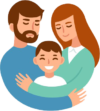Reading is the process of taking and understanding that information from written language. The skill of reading has two main parts: the mechanical elements (decoding), and comprehension.
Reading and Learning Disabilities
There are many places in the process of learning to read where things can get off track. Similarly to math, reading is an accumulation of skills, and missing out on an early element will impact later elements negatively; for example, if the mechanical elements don’t become automatic, comprehension skills can’t fully develop. Problems can occur at any of the learning stages mentioned above.
What is Dyslexia?
Dyslexia is a learning disorder that involves difficulty reading due to problems identifying speech sounds and learning how they relate to letters and words (decoding). Also called reading disability, dyslexia affects areas of the brain that process language.
People with dyslexia have normal intelligence and usually have normal vision. Most children with dyslexia can succeed in school with tutoring or a specialized education program. Emotional support also plays an important role.
Symptoms
Before school
Signs that a young child may be at risk of dyslexia include:
- Late talking
- Learning new words slowly
- Problems forming words correctly, such as reversing sounds in words or confusing words that sound alike
- Problems remembering or naming letters, numbers and colors
- Difficulty learning nursery rhymes or playing rhyming games
School age
Once your child is in school, dyslexia signs and symptoms may become more apparent, including:
- Reading well below the expected level for age
- Problems processing and understanding what he or she hears
- Difficulty finding the right word or forming answers to questions
- Problems remembering the sequence of things
- Difficulty seeing (and occasionally hearing) similarities and differences in letters and words
- Inability to sound out the pronunciation of an unfamiliar word
- Difficulty spelling
- Spending an unusually long time completing tasks that involve reading or writing
- Avoiding activities that involve reading
What Helps?
- Identify the Problem.
In all cases, identifying where the problem begins is crucial to figuring out how to fix it.The problem may be a simple knowledge gap, which, when addressed, is permanently corrected; it can also be a neurologically based learning issue like an LD.
- Start Early.
In cases of knowledge gaps, if they are noticed early on, through early screening and intervention processes like the Web Based Teaching Tool, weaknesses can be addressed and larger lags avoided. In cases of LDs, early identification allows for timely interventions to begin; these can include finding appropriate remediation methods, alternative teaching strategies and accommodations, such as assistive technologies, which, once learned, can level the playing field for the student.
- Be Sensitive.
Early identification of the problem and timely intervention are the ideal situations, as they allow young students to get back on track and/or find appropriate approaches without having to endure the social/personal negative effects of struggling in school. For older students and adults the cumulative social/personal negative effects of struggling in school need to be addressed along with gaps in reading skills.
References:
https://www.ldao.ca/introduction-to-ldsadhd/snapshots/reading-and-lds-a-snapshot/
https://dyslexiclibrary.com/2018/10/31/6-things-that-scare-dyslexics/




Leave a Reply
You must be logged in to post a comment.